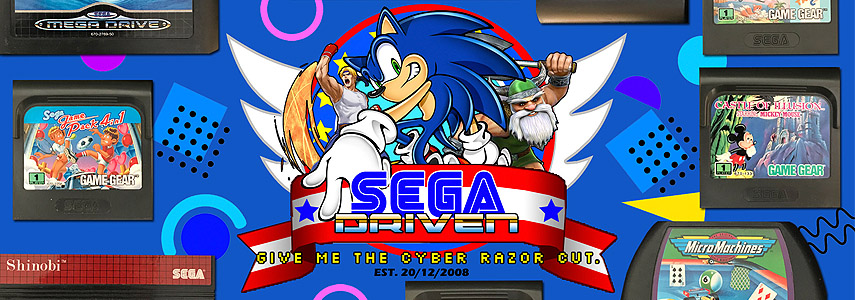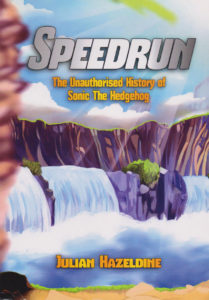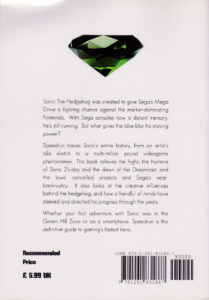Review of Julian Hazeldine’s Speedrun: The Unauthorised History of Sonic the Hedgehog
Alarm bells started to the ring the moment I started reading Julian Hazeldine’s Speedrun: The Unauthorised History of Sonic the Hedgehog. The first sentence of the book’s introduction reads, “The funny thing is, the Sonic the Hedgehog titles aren’t actually my favourite series of video games.” Well. This is the opening sentence of book about the history of Sonic the Hedgehog. This is a book with a very particular audience that will likely consist of Sonic fans. Sonic fans are generally quite an enthusiastic bunch and I’m not getting the impression that Hazeldine is really on the same level as them. As beginnings go this isn’t a very strong start.
Hazeldine then goes on to explain that being freed from the constraints of writing a book about Sonic the Hedgehog in an official manner means that he has prepared a more critical assessment of the franchise that also includes a larger focus on the TV shows, comics and novels. This last statement intrigues us the most as these are elements of the Sonic franchise that are largely ignored in official print media like Pix’n Love’s The History of Sonic the Hedgehog. Low and behold when Hazeldine begins to express his love for things like the Virgin Publishing series of Sonic novels from the mid-nineties and Fleetway’s Sonic the Comic he shares a passion that embraces the reader. I for one have since picked up the Virgin novels off the back of Hazeldine’s recommendation and I genuinely hope they delight me in the same way they do Hazeldine.
The problem is these moments are few and far between and Speedrun generally reads like a truncated overview of the franchise’s key moments, picking out certain games for slightly closer investigation. Sadly when these things are discussed they are often done in an overly critical manner that quickly becomes tiresome to read. Hazeldine expresses his disdain for things like the level design in Sonic CD and the childish plots of Sonic Colours and Lost World. He even dislikes the Adventures of Sonic the Hedgehog and Sonic the Hedgehog (SatAM) cartoons; two shows which have gained a considerable cult following with one of them influencing the still running Archie series of Sonic comics. One particular opinion I didn’t share with Hazeldine is that he thought Open Your Heart (the theme from Sonic Adventure) was one of Crush 40′s weaker songs. Now that’s a new one on me.
Now my own differing opinions from the author’s shouldn’t really spark any negative feelings towards him as long as the points are well argued, but Hazeldine often attributes his personal opinions to the Sonic community in general. A key example is when Hazeldine’s discusses the aesthetic of Sonic Spinball and simply passes it off as something that is, “unlikely to be anyone’s favourite.” How do you know that Julian? After spending 15 years in the Sonic online community I can tell you that nobody agrees on anything so it seems strange that we are told to take Hazeldine’s opinion as gospel on numerous occasions.
It’s also a shame that so many typos work their way into the book. A little more time proof-reading could’ve cleaned this up but it’s sad to see a published work include grammatical errors like “Sego of America” and “Sonic Boom (52” which is apparently the title of the cartoon series launching later this year.
The fact of the matter is Speedrun doesn’t really offer the seasoned Sonic fan anything you don’t already know or can’t read on Wikipedia. There was room for Hazeldine to do something dramatically different and showcase the Sonic franchise from a completely different angle. This could have been a humorous portrayal of being a Sonic fan or focussed more closely on things like the novels and comics as they aren’t really discussed nearly as often as other Sonic media. What we get is a pretty short exploration of the franchise’s history that tends to focus on the negatives far too often. As a Sonic fan I don’t really want to read about Sonic’s weaknesses or what could have been done better; I want to know what’s made the character so successful and what pieces of media are worth my time. When Hazeldine touches on the media he enjoys Speedrun is a much more entertaining read but these moments are unfortunately few and far between.
Fair play to Hazeldine for producing a written work about the Sonic franchise as outside Pix’n Love’s 2012 offering there really isn’t much available. It’s personally very humbling to see this written from a British perspective as it means Hazeldine touches on things like the Summer of Sonic convention which have continued to be an extremely enjoyable event that shows how strong the Sonic franchise is in the UK. However as I’ve already mentioned, these moments of positivity are a rare occurrence in Speedrun: The Unauthorised History of Sonic the Hedgehog and it’s a difficult book to recommend to anyone other than the most dedicated of Sonic fans.
Written by Sonic Yoda on 1/7/2014
You can purchase Speedrun: The Unauthorised History of Sonic the Hedgehog on physical paperback or as a downloadable Kindle Edition.











